Post Twelve - Overland to Bangkok
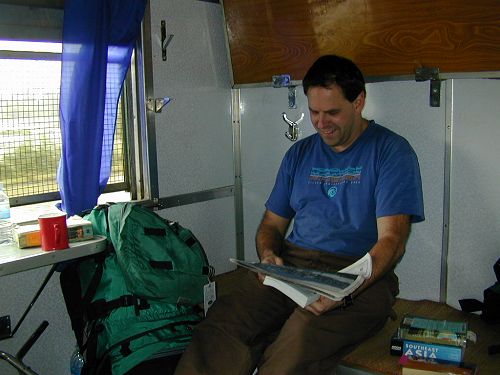 Hard Sleeper Hard SleeperThe road from Guilin to Bangkok was a hard one. In Guilin we opted for a night bus to take us to the border with Vietnam. This became the night bus from hell. What was described as an executive sleeper bus was an old bus filled with tiny bunk cots about 5 feet long. I'm 6 feet long. I actually got some sleep on that bus. The next bus we got on in Nanning had double beds 5 feet long by about 4 feet wide. I got to share this bed with Craig who was becoming sick. We huddled together under a filthy blanket as the bus headed toward the border. We spent a quick two days in Hanoi. Craig was sick for much of our time there. I wandered around, fending off vendors and trying not to get hit by the multitudes of motorbikes on the road. Time was growing short so we opted for a night train to Dong Ha where we could catch a series of busses to Laos and then Thailand. We got 'hard sleeper' for the trip down. Unlike China, in Vietnam, hard sleeper means the bed is hard. Literally a board and a pillow. We pulled all our clothes out of our bags to serve as a mattress and actually spent a fairly comfortable night on board. |
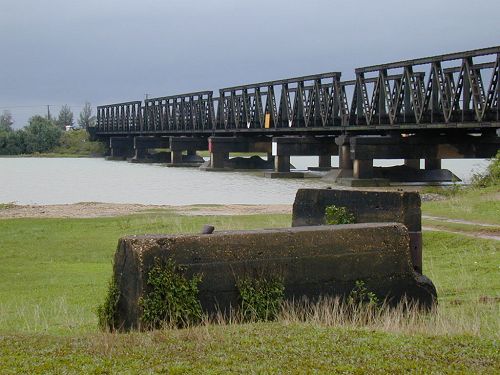 The DMZ The DMZWhen we reached Dong Ha around noon we found that the bus for Laos only leaves in the early morning. So, with the rest of the day to kill, we decided to take a tour of the former DMZ (de-militarized zone) of the Vietnam War. I know little about the war so it was good for me to have a look around the area that saw some of the most intense fighting. It was a large group so we had two guides, one sympathetic to the cause of the south and one to the cause of the north. We would reach an area, split into groups, and they would each give their accounts to their respective groups. If you stood between the two groups you could hear them both. One talking about the ruthless Americans and South Vietnamese bombing women and children and the other discussing how the North Vietnamese ravaged the country before, during and after the war. This is a photo of the bridge that spanned the DMZ. After the war, this bridge literally reunified the country. |
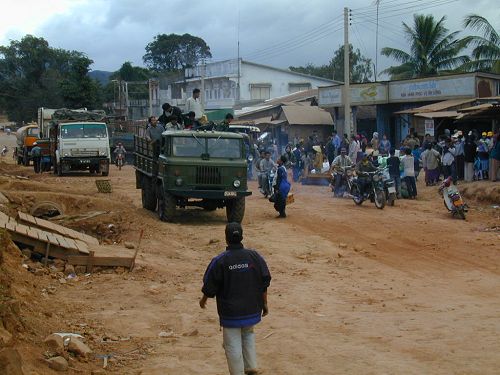 Laos LaosAfter arriving back at our room after the tour of the DMZ, I felt pretty tired so I went to bed early. I spent the night alternating between running to the bathroom and lying in my bed in feverish delirium. The food they gave us on the train must not have agreed with me. Thankfully, my fever broke around midnight and by 5 am (when we left for Laos), I was able to get on the bus. Actually we took a minivan for the 80 km ride to the Laos border. However, at 5 in the morning it was dark and the lights on our van didn't work so we spent the first 45 minutes playing with the fuse box trying to get the lights to come on. Eventually it got bright out enough to drive. The border was relative chaos. We were quickly stamped through and came into Ban Katai (pictured). I wouldn't really call it a town. More like a couple of stores on a dirt road. Here we waited two hours for our bus to fill up and take us the remaining 300 km to Savannakhet on the Thai border. |
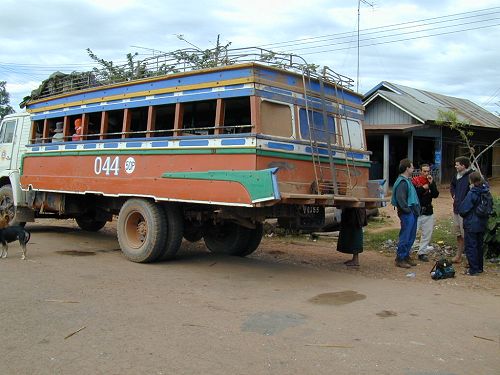 Our Bus Our BusThis was our bus. It was really just a truck with a bus carriage welded on. The seats were padded benches and there was no glass in the windows. Actually I didn't care. We were on our way to Thailand and I would have rode in just about anything to get there. |
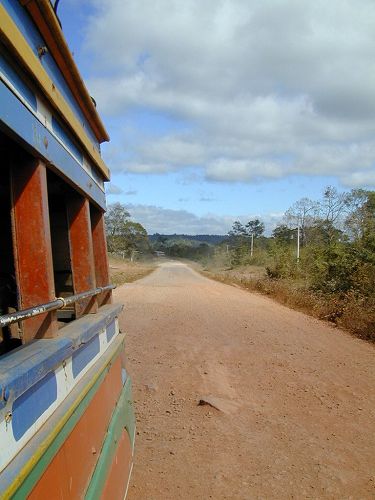 Dusty Highway Dusty HighwayThis is a view of the road to Savannakhet. It was 300 km of dusty, potholed dirt road and it took us all day to travel it. Along the side of the road we saw plenty of signs warning of unexploded ordinance. During the Vietnam War, the US dropped more bombs on Laos then they did in Vietnam in an effort to destroy the Ho Chi Minh Trail. Today, Laos and Cambodia have some of the most unexploded ordinance in the world. I saw kids with metal detectors, finding and digging up the old bombs to sell as scrap. Central Laos was probably the most 'third world' place I have ever been. After seeing how people live there, it's hard to complain about life in the States. It also makes me appreciate the people and organizations that are trying to help these people. One organization doing work like this that I can recommend highly is the Hope Alliance. |
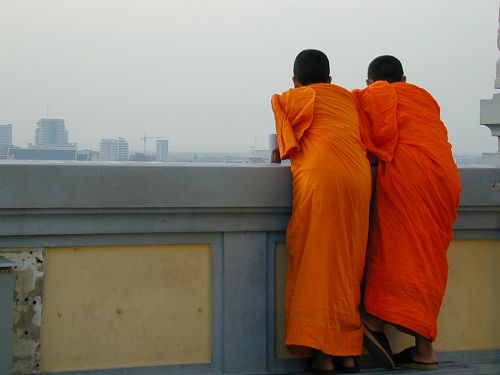 Thai Monks Thai MonksIn Savannakhet we crossed the Mekong River into Thailand and made our way to Bangkok. It took another night on a train but we finally arrived. While wandering through Bangkok, I took this photo of two young monks at the top of Wat Saket. |
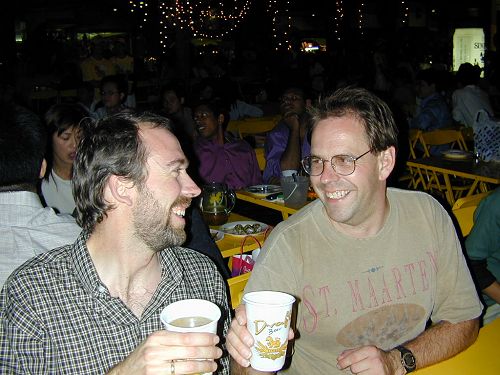 Merry Christmas Merry ChristmasOn Christmas Eve, Craig and I spent our last night together at an outdoor beer garden at the Bangkok World Trade Center. Being mainly Buddhist, the Thai don't celebrate Christmas. In fact, the beer garden was set up mainly for New Year's, which they do celebrate (heartily). We ordered beer, appetizers, chicken satay, grilled prawns, more beer, grilled fish and finished it all up with a few more beers. It was a hard road from Beijing to Bangkok - not what I would call a standard vacation. Through it all Craig was a trooper. We spent 5 nights on trains and one night on the bus ride from hell. We both got sick in Vietnam and had to endure crossing Laos on a dusty, jerking truck. We never got to the beach, but, like I said, Craig is always up for an adventure and at least he went home with some stories to tell. |
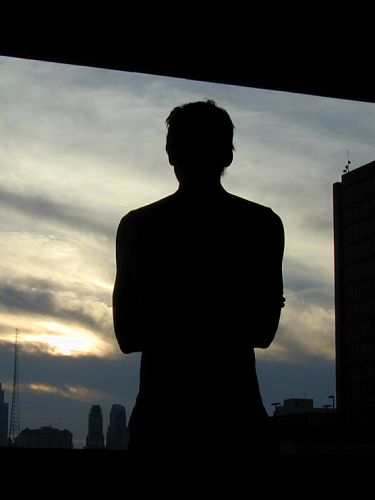 Success SuccessAlone after Craig left, I stayed in my hotel room and washed everything I had - my clothes, my pack, and even my money belt. Everything was coated with grime and dust from the road. Watching the sunrise from my room on Christmas day I looked out over the city and felt proud. I'd reached Bangkok overland from Europe - the classic journey. All the weeks spent studying the route, getting visas, and wondering whether it would work had paid off. And today was Christmas bringing the best present I could ask for - Karen was flying in to rejoin me for a tour of Southeast Asia, Australia, and New Zealand. |
Post Twelve Contents
Copyright 2002
Scott & Karen Semyan